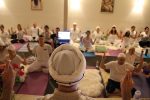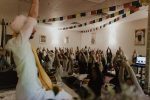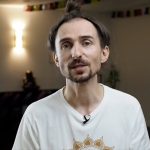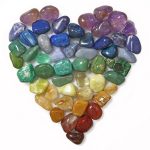Conversations with Cosmin — Part Three: In Search of Our True Nature
The Truth of Yoga is in the experience, and you don’t necessarily need to know the story of its origins in the Himalayan Mountains, or to understand the powerful science behind Yoga, to experience its benefits. But this fascinating knowledge will empower both the beginning and advanced practitioner of Yoga alike.
In a series of conversations, Cosmin shares the origins of this amazing knowledge with us, and how it has served humanity for thousands of years. It’s a story not just of Yoga’s past; but of its past, its present, and its future in our modern world.
In Part Three: In Search of Our True Nature, Cosmin explores what Meditation is, and how it can guide us to discover our True Nature… Our Spirit.
What is Meditation?
Now that we’re healthy, going to the gym, going to Yoga, stretching, eating healthy… What’s next? We’re comfortable, we have shelter, we have an income, we have food, and we feel good. Then what comes next?
That’s when we have the opportunity to realize that there’s something more. We wake-up and say, “Well, this is taken care of, now something else is starting to bother me,” or, at least we’re beginning to notice something else is going on.
The more involved we are in this very fast-paced society (and we don’t really have much of a choice, do we?) the more we’re realizing that there’s something like a computer inside of us which is driving us nuts! We call that the Monkey in our mind.
There’s something there — let’s call it software — that doesn’t want to stop. It doesn’t give us a break, no matter what we do. When we’re sleeping, we’re dreaming: No rest! When we’re trying to nap or even to go to sleep: We toss and turn. During the day, it doesn’t matter the time: We’re thinking.
It’s like a mental shower.
Then when are we going to get a break? If the software isn’t working properly — think about your computer or your cell phone: No matter how much you polish that phone, or how much you clean that computer and charge that battery — if the software isn’t maintained properly — then your laptop might as well be used as a cutting board: It won’t work anymore.
So that’s what’s happening today from having so much technology all around us… So much information… We’re living at such a fast pace, that we — or the software inside of us — simply can’t keep up!
The software can keep up, by all means. It just needs some maintenance. (And thousands of years ago, by the way, it was pretty much the same software as we have today — pretty much — I will say that perhaps it was a little bit less up-to-date than it is today. If you look at the new generation of kids, they are growing up with some pretty upgraded software due to all the technology that surrounds them!)
But there is a way to keep that software clean and clear, and to empty the garbage bin like you do with your computer or your phone. There is a way to run software through your main computer to maintain it at its optimum level every single day. And the only proven method is Meditation.
We don’t have a better method, at least that I’m aware of, that works better than Meditation. It’s like a mental shower. You take a physical shower to take care of your physical body, so you take a mental shower for your mind.
It’s a cleansing process.
Nobody ever complained about Meditation, saying like, “Oh, it doesn’t work.” Or even worse, “I got hurt!” What’s going to happen when you meditate? You will close your eyes, right? And then your mind is going to dump, initially, thousands of thoughts onto you. Well that is Meditation.
At first you’re going to think about everything that’s super negative, things that you did, things that you were supposed to do, things that you forgot, etc.
That’s why so often when we try to meditate at home we say, “I can’t meditate!” Why? Because we close our eyes, and we have our spine straight, and we listen to some app or just stay in silence, and then two minutes later… We open our eyes, and we need to run!
Because, initially, what Meditation is doing is it’s just going through our mind — through our subconscious mind — and it’s starting to clean it. So the meditation is kgoing, and in your conscious mind, and all you see is: “I need to do this.” “That guy told me that.” “My boss was mean today.” “I forgot something…” “Oh, let me check my computer as soon as I’m done with this meditation.”
It’s just a cleansing process. That’s all it is. It’s cleansing, cleansing, cleansing. That’s all that Meditation is… Initially.
Meditation is a limb of Yoga that allows one to take care of the software — let’s just say that the mind is software — and more than that, the goal of Meditation is to eventually go beyond that.
Meaning Meditation will take you into a space where there is no mind. Where there are no more thoughts. Where there are no dreams. Where there are no hopes… and also no fears. Where there is nothing. It just is. Even when I say “is,” that’s saying too much.
I should just be quiet here for a few moments… This is what Meditation is:
…
Okay. That was Meditation!
A window into your True Nature.
In that nothingness… In that void… In that emptiness… there’s just peace. This is your true nature. This is where the spirit comes forward. This is where “You” is — where You are. The physical body is just an outward layer.
Without the physical body you can’t smell anything, you can’t touch anything, you can’t see or enjoy life through the senses. That’s all there is to it: Legs are designed to move you from A to B — so you can enjoy life. Hands are there to feed yourself, to help somebody, to do an offering, or to do work. It just about allowing you to interact with the physical world.
But if you only resort to these physical realities, then what about all these other possibilities? What about exploring the mind? And what about going beyond the mind… Going into the unknown where everything comes from… Going into the spirit?
What’s next?
Now that we understand what Yoga and Meditation are, how do we incorporate them effectively into our daily lives, to empower our practice and to make it work for us?






